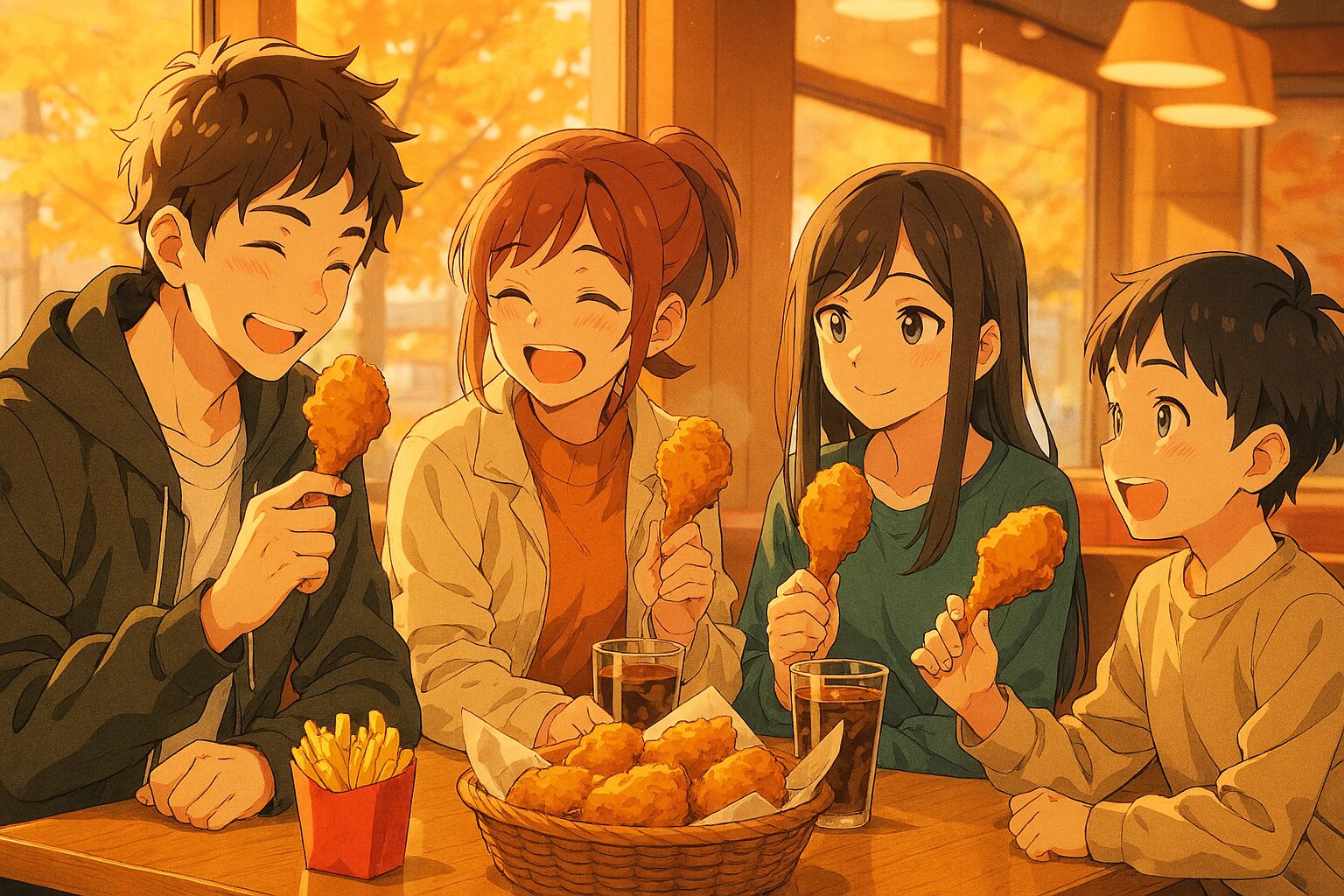November 21st. Do you know what day this is in Japan? It’s not just an ordinary weekday. It is a monumental day that changed Japanese food culture, specifically the history of fast food. It is “Fried Chicken Day.”
For our international readers, fried chicken might be a soul food from the American South or a daily meal. However, here in Japan, fried chicken is deeply connected to a specific brand and has established a unique status as a “feast for special occasions.”
In this article, we will dig deep into the “Fried Chicken Revolution” in Japan that started on this day in 1970, and the culture of “acceptance and adaptation” unique to Japan that can be seen through it.
History: The Challenge began in Nagoya in 1970
On November 21, 1970. A store opened in the suburbs of Nagoya City, Aichi Prefecture, Japan. It was the “Nagoya Nishiten,” the very first Kentucky Fried Chicken (KFC) store in Japan.
To commemorate this day, KFC Holdings Japan established “Fried Chicken Day.”
The Economic Miracle and the World Expo
Let’s look at the historical background. 1970 was a symbolic year for Japan. The “Japan World Exposition (Osaka Expo ’70)” was held in Osaka, and the whole of Japan was boiling with hope for the future and admiration for foreign culture. KFC, which had opened an experimental store at this Expo, was well received, and with that momentum, the official first store opened in November of the same year.
However, at that time, Japan did not have much of a custom of “eating meat with your hands.” Also, considering consumer prices in Japan at the time, fried chicken was by no means a cheap food, and it is said that they struggled initially. There are anecdotes that the red and white striped roof and the statue of Colonel Sanders standing at the storefront were so alien to the Japanese people at the time that they didn’t understand what kind of shop it was.
The “Christmas” Strategy that Turned Things Around
What saved the struggling KFC was a marketing strategy that sounded almost like a lie. Inspired by a foreigner living in Japan who came to the store saying, “I can’t get turkey in Japan for Christmas, so I’ll celebrate with fried chicken instead,” the sales manager launched a massive campaign: “Kentucky for Christmas.”
This was an explosive hit. In Japan, where Christian customs were not common, fried chicken was accepted as a “fashionable American Christmas culture.” November 21st, the opening day of this first store, can be said to be the beginning of that legend.
Cultural Analysis: The Uniqueness of “Chicken” and “Yoshoku” in Japan
What aspects of Japanese culture can we decipher from Fried Chicken Day on November 21st? It is the Japanese skill of “localization of foreign culture” and their special attachment to chicken meat.
Coexistence of “Karaage” and “Fried Chicken”
Japan originally has a powerful national food called “Karaage.” It is chicken marinated in soy sauce, ginger, and garlic, coated with flour or starch, and deep-fried. Usually, overseas fried chicken and Japanese Karaage seem to be competitors.
However, Japanese people clearly distinguish between the two.
- Karaage: A side dish for rice, a staple for Bento boxes, an appetizer at Izakaya (Daily Life).
- Fried Chicken (KFC): Parties, Christmas, a little luxury (Extraordinary / Special Days).
Since the first store opened on November 21st, fried chicken has taken root in Japanese society not as a “daily meal” but as “entertainment.” The style of sharing bone-in meat with everyone matched the Japanese culture of family gatherings.
Fast Food that Evolved Uniquely
KFC Japan is known for having its own quality control standards, different from the main stores in the US. Detailed adjustments have been made to suit the delicate taste buds of Japanese people, such as suppressing greasiness and using a unique recipe for biscuits.
Protecting the taste of “Original Chicken” while developing and establishing Japan-exclusive items like the “Japanese-style Chicken Cutlet Sandwich.” This is exactly the traditional Japanese method of “Yoshoku” (Western food), where Western cuisine has been modified to suit rice since the Meiji era.
How would you celebrate this day?
November 21st, Fried Chicken Day. If you are currently in Japan, please stop by a nearby KFC or even the hot snack corner of a convenience store (the quality of Japanese convenience store chicken is world-class!).
And what is the presence of “fried chicken” in your country? Is it just fast food? Or is it a special meal eaten after Sunday service?
Food culture is a mirror that reflects the history of the country and the lives of its people. Why don’t you bite into some piping hot chicken today, savoring the miracle that a single ingredient and a single dish can cross borders and be loved with a completely new meaning in a totally different culture?
Related Links & References
- Japan National Tourism Organization (JNTO) – Discover Japanese food culture and travel info.
- What’s Today’s Special Day Series – Read more about Japanese special days.
11月21日は日本の「フライドチキンの日」。なぜ日本人はこの味に魅了されたのか?
11月21日。この日が日本において何の日かご存知でしょうか。単なる平日ではありません。日本の食文化、特にファストフードの歴史を変えた記念すべき日、それが「フライドチキンの日」です。
海外の読者の皆様にとって、フライドチキンといえばアメリカ南部のソウルフードであり、日常的な食事かもしれません。しかし、ここ日本においてフライドチキンは、ある特定のブランドと深く結びつき、さらには「特別な日のご馳走」という独自の地位を築き上げています。
今回は、1970年のこの日に始まった日本のフライドチキン革命と、そこから見える日本独自の「受容と変化」の文化について、深く掘り下げていきます。
歴史:1970年、名古屋から始まった挑戦
1970年(昭和45年)11月21日。日本の愛知県名古屋市近郊に、ある店舗がオープンしました。それが「ケンタッキーフライドチキン(KFC)」の日本第1号店、名西店です。
この日を記念して、日本KFCホールディングス株式会社が「フライドチキンの日」を制定しました。
高度経済成長と万国博覧会
時代背景を見てみましょう。1970年は日本にとって象徴的な年です。大阪で「日本万国博覧会(大阪万博)」が開催され、日本中が未来への希望と、海外文化への憧れに沸き立っていました。この万博で実験店として出店していたKFCが好評を博し、その勢いのまま同年11月に正式な1号店がオープンしたのです。
しかし、当時の日本には「手で肉を持って食べる」という習慣があまりありませんでした。また、当時の日本の物価からするとフライドチキンは決して安い食べ物ではなく、当初は苦戦を強いられたと言われています。赤と白のストライプの屋根や、店頭に立つカーネル・サンダースの人形は、当時の日本人にとってあまりに異質で、何のお店か理解されなかったという逸話も残っています。
起死回生の「クリスマス」戦略
苦戦していたKFCを救ったのは、ある「嘘」のようなマーケティング戦略でした。日本に住む外国人が「日本ではクリスマスにターキー(七面鳥)が手に入らないから、代わりにフライドチキンを祝う」と言って来店したことをヒントに、営業担当者が「クリスマスにはケンタッキー」というキャンペーンを大々的に打ち出したのです。
これが爆発的にヒットしました。キリスト教の習慣が一般的ではなかった日本において、「アメリカのオシャレなクリスマス文化」としてフライドチキンが受け入れられたのです。この1号店のオープン日である11月21日は、まさにその伝説の始まりの日と言えるでしょう。
文化考察:日本における「鶏肉」と「洋食」の独自性
11月21日のフライドチキンの日から、私たちは日本文化のどのような側面を読み解くことができるでしょうか。それは、日本人の「外来文化の日本化(ローカライゼーション)」の巧みさと、鶏肉に対する特別な愛着です。
「唐揚げ」と「フライドチキン」の共存
日本にはもともと「唐揚げ(Karaage)」という強力な国民食があります。醤油や生姜、ニンニクで下味をつけた鶏肉に粉をまぶして揚げる料理です。通常、海外のフライドチキンと日本の唐揚げは競合するように思えます。
しかし、日本人はこの二つを明確に使い分けています。
- 唐揚げ:ご飯のおかず、お弁当の定番、居酒屋のつまみ(日常)
- フライドチキン(KFC):パーティ、クリスマス、ちょっとした贅沢(非日常・ハレの日)
11月21日に1号店がオープンして以来、フライドチキンは「日常の食事」ではなく「エンターテインメント」として日本社会に根付きました。骨付きの肉をみんなで囲むスタイルが、日本の家族団欒の文化とマッチしたのです。
独自の進化を遂げたファストフード
日本のKFCは、アメリカの本店とは異なる独自の品質管理基準を持っていることで知られています。日本人の繊細な味覚に合わせ、脂っこさを抑えたり、ビスケットのレシピを独自のものにしたりと、細かな調整が行われてきました。
「オリジナルチキン」の味を守りつつも、日本限定の「和風チキンカツサンド」などを開発し、定着させる。これは、明治時代以降、西洋料理を「洋食」としてご飯に合うように改造してきた日本の伝統的な手法そのものです。
あなたなら、この日をどう祝いますか?
11月21日、フライドチキンの日。もしあなたが今日本にいるなら、ぜひ近くのKFC、あるいはコンビニエンスストアのホットスナックコーナー(日本のコンビニチキンのレベルの高さは世界一です!)に立ち寄ってみてください。
そして、あなたの国では「フライドチキン」はどのような存在でしょうか? ただのファストフードですか? それとも、日曜日の礼拝の後に食べる特別な食事でしょうか?
食文化は、その国の歴史と人々の生活を映し出す鏡です。一つの食材、一つの料理が国境を越え、全く異なる文化の中で新しい意味を持って愛されている。その奇跡を噛み締めながら、今日は熱々のチキンを頬張ってみてはいかがでしょうか。
関連リンク・参考情報
- Japan National Tourism Organization (JNTO) – 日本の食文化や旅行情報はこちら。
- What’s Today’s Special Day Series – その他の日本の記念日についてはこちら。



コメント